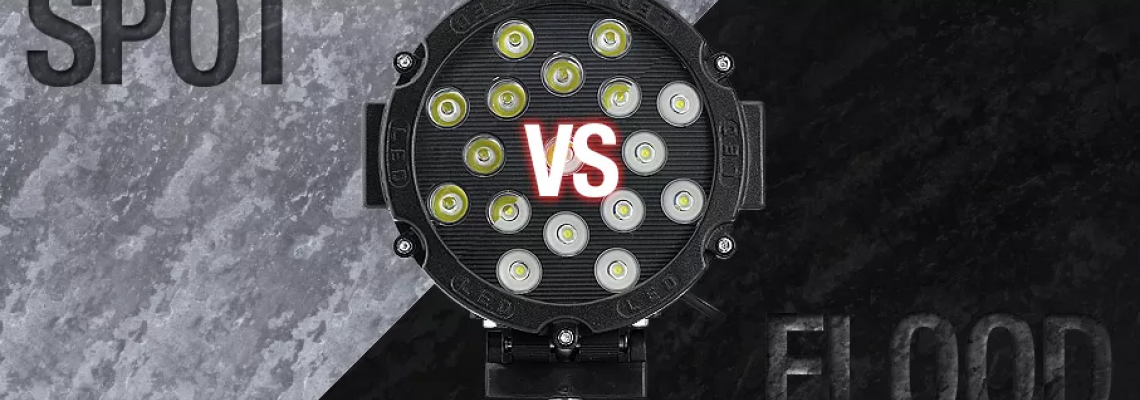Spot Lights vs. Flood Lights

Spot Lights vs. Flood Lights
When to Use Which
The abundance of alternatives available can easily confuse when choosing lighting for a work zone. Even if you have focused your search on floodlights and spotlights, you might still be unsure which type is best for utility work lighting. If you're unsure, this information should assist you in selecting the best kind of light for your needs.
Beam Spread
The concept of beam spread is among the most perplexing in the field of LED lights. Incandescent lights need reflectors and diffusers to direct the light properly. In contrast, LED lights are great at producing focused light.
Incandescent lights frequently waste a shocking amount of electricity. In contrast, LED chips only send light in one direction. With a fraction of the conventional cost, you can achieve a fantastic light pattern, depending on the type of light you select.
Beam spread measures the dispersion of light from the actual light source. The area that needs light and the distance from the light source will decide the best beam spread for a utility work light.
Types of Beam Spread
Today's market offers a vast assortment of lights for purchase. Each of these lights has advantages and disadvantages of its own.
- Omni-directional – Lights that are omnidirectional and spread out in all directions. Table lamps, ceiling chandeliers, and other home applications frequently use this lighting.
- Directional -A single direction is the focus of directional beams. LED lights are the only genuinely directed lighting and are also frequently utilized in residential settings.
- Spotlights -Beam angles used by spotlights are less than 45 degrees. The focused beams are very bright. This makes them perfect for areas that need strong lighting in low light.
- Floodlights -Beam angles for floodlights are typically between 120 and 130 degrees. People commonly use these lights in sports arenas and for billboard lighting. Their wide beam spread makes them perfect for lighting large work areas.
LED Spot vs. Flood
Spotlights and floodlights look similar when you hold them. However, their differences become clear when you use them. Spotlights help provide a concentrated beam of light over large areas. Floodlights illuminate wider regions to improve visibility.
The Floodlight Advantage
One of the most effective lighting options today is the floodlight, which may be applied in many contexts. Floodlights are high-intensity, broad-beamed lights that, as their name implies, "flood" the surrounding area with light.
Because of their robust nature, floodlights are perfect for places without sunshine. Athletic events provide a prime illustration. The lighting levels must reach high enough standards to achieve broadcast quality because producers frequently televise the content.
Additionally, floodlights work well as emergency lights. Both accident scenes and search and rescue missions use the intense beam.
In addition, floodlights give the region they are used in more security. You can fit them with motion sensors to prevent using needless electricity as security lights. In other situations, people might use them continuously.
The finest places for floodlights are strategically placed around the area's perimeter, which needs to be lit. Sports fields provide a prime illustration. To create the effect of the midday sun, the floodlights are placed to shine on specific areas of the field.
In work zones, floodlights are utilized comparably. When arranged in sequence inside light towers, floodlights provide the closest thing to natural sunshine.
The Spotlight Advantage
Conversely, spotlights work best when concentrated beams are needed to complete a task. They feel equally at home on the job site and frequently serve as searchlights for maritime applications. The ability of spotlight beam patterns to project a focused, far-reaching light beam is well known. Spotlights are the most effective option for work areas that need highly concentrated lighting.
Using the appropriate evening lighting can reduce accidents in a work zone. Workers have chosen nighttime to complete some of the necessary road work in the United States. The vehicles on the highways facilitate the construction crews' ability to do their work with the least disruption. There are fewer multi-vehicle auto accidents and mile-long traffic bottlenecks for drivers.
In the summer, it's also more relaxed at night, which is more comfortable for construction workers. Low light levels, however, provide unique safety risks. Using the appropriate illumination alternatives can significantly decrease accidents that result in death. For a work zone, the best illumination may usually be achieved by combining spotlights and floodlights.
Why Choose LED Lights
New developments in LED technology have made it possible to create maximum-intensity illumination at a lower operating cost. LED lights are also eco-friendly since they consume very little electricity.
LED lights have a very long lifespan of up to 50,000 hours, during which they may produce bright light. Compared to halogen or incandescent lights, that is a significant benefit. The lifespan of these lights is 2,500–3500 hours.
You won't need as many LED lights to brighten your work area. They are some of the brightest lights available today. Reduced operating expenses and less energy use result from using fewer bulbs.
LED lights are more robust than halogen, fluorescent, and incandescent lights. Some of them are perfect for outdoor operations since they are weatherproof.
LED lights may seem more expensive initially, but the advantages will significantly exceed the cost in the long run. LED spotlights and floodlights can start saving you money in as little as two years because of:
- Reduced electrical usage
- The need for fewer bulbs
- Long lifespan
Using the right LED scene lights is essential to protect your employees' safety and the cars driving through the work zone. Spotlights and floodlights can help ensure everyone's safety while workers make essential road repairs. With any luck, this advice may assist you in selecting the appropriate lights for your work area.